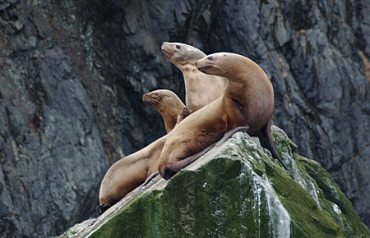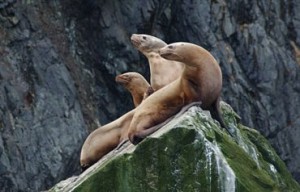Some of the rules that limit commercial fishing in the western Aleutian Islands are no longer needed to protect endangered Steller sea lions, federal regulators said in a management document issued Wednesday.
In a 281-page biological opinion, the National Marine Fisheries Service said a new arrangement of Aleutian fishing seasons for pollock, Atka mackerel and Pacific cod has resulted in a harvest system that does not pose additional jeopardy to the fish-eating sea lions.
The biological opinion’s stamp of approval is expected to bring regulatory changes that “would relieve roughly two-thirds of the economic burden imposed on Aleutian Islands’ fishermen” by the current sea lion protection rules, NMFS said in a statement.
“Finding a way to protect endangered sea lions while minimizing costs to the fishing industry is a real challenge,” Jim Balsinger, NFMS Alaska regional administrator, said in the statement. “I applaud the North Pacific Fishery Management Council and stakeholders for recommending a new suite of measures that effectively balances those two objectives.”
The fishing industry and its supporters cheered the new biological opinion, a document required under the Endangered Species Act.
“We are grateful that NOAA Fisheries has taken a new updated view of their 2010 decision,” Thomas Mack, president of the fishing-dependent Aleut Corp., said in a statement. “This means increased fishing opportunities especially in Adak and other areas of the Aleutians. I also thank the North Pacific Fishery Management Council for their continuous determination to bring fishing back to the Western Aleutians.”
But environmentalists were dismayed by the new NMFS position.
“Today’s decision is a clear statement from the National Marine Fisheries Service that large-scale industrial fishing is more important than stewardship, science, and sustainable fisheries,” Susan Murray, deputy Pacific vice president for the environmental group Oceana, said in a statement.
“In the more than 20 years since the Western Population was first protected under the Endangered Species Act, steps have been taken to reduce competition with fisheries. Now, just as we were seeing progress, the agency has taken a huge step backwards,” Murray said.
Brandee Gerke, a Juneau-based NMFS fishery management specialist official who helped draft the biological opinion, conceded that the new recommendation “does relax some of the measures” that are in place right now. But NMFS has concluded that the new harvest plans approved by the North Pacific Fishery Management Council are sufficiently protective of sea lions, she said.
“We don’t think that it’s a rollback,” Gerke said.
There have been important changes in the past four years that justify a finding that expanded fishing in the Aleutians will not jeopardize Steller sea lions, she said.
The way the harvests will be conducted — with new measures to spread fishing over different time periods and different areas to prevent localized depletion — is different from the harvests evaluated by NMFS in 2010, she said. There has also been new information about the beleaguered Steller sea lions and their potential interactions with the fisheries, she said.
Steller sea lions, the world’s largest eared seals, suffered a population crash in the late 20th century. The western Alaska population fell by 75 percent from 1976 to 1990. The population was listed in 1990 as threatened and in 1997 as endangered. While parts of the western population appear to have stabilized, the sharp decline has continued in the western Aleutians, where the Steller sea lion population fell by about 45 percent from 2000 to 2009, according to NMFS research.
Concern for those Aleutian sea lions led to the rules issued in 2010, which were put in place the following year.
But NMFS’ Aleutian Islands fisheries restrictions were staunchly opposed by fishing companies and local communities in the region. Representatives said the protections, based on a prior biological opinion that concluded that sea lions were deprived of food in certain Aleutian locations, unfairly shut down fisheries in important places and at important times of the year.
The conflicts produced a complicated legal fight; fishing groups, communities, Native corporations and the state of Alaska sued NMFS in 2010 and 2011 to overturn the restrictions. Rulings at the U.S. District Court and 9th Circuit Court of Appeals level mostly backed the agency and its decision to impose the fishing limits, but the district court ordered NMFS to complete a full environmental impact statement on the fishing restrictions.
That environmental impact statement is still being completed, said agency spokeswoman Julie Speegle.
Numerous hypotheses about the sea lions’ decline are being explored by scientists.
The new biological opinion is expected to result in new Aleutians fisheries rules next year, NMFS said.








